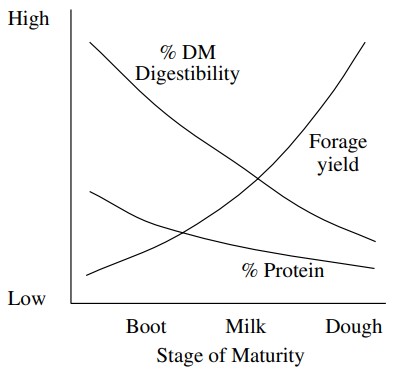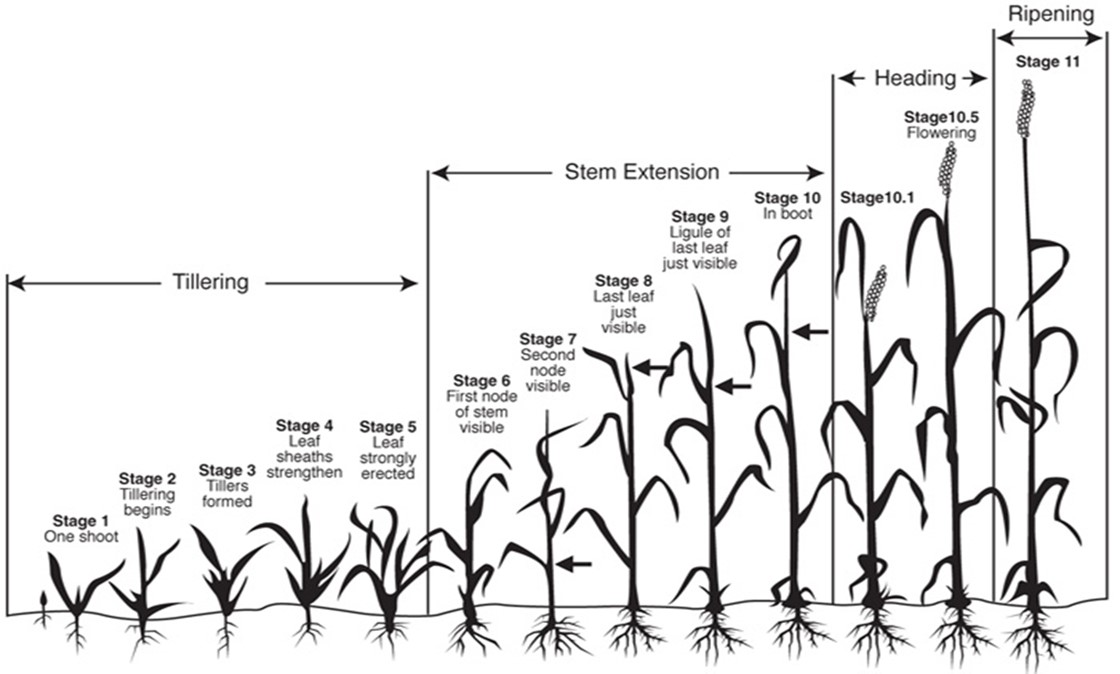
Co-author: Jon Pretz, Ph.D., dairy nutritionist
In many parts of the U.S., small-grain forages are increasing in popularity and can make excellent feed for milk cow rations when harvested at the correct stage of maturity and put up at proper moisture levels. These forages can provide additional fiber when carryover from the previous year is limited and can be used to supplement traditional hay and corn silage diets when there is a risk of limited summer forage production due to growing conditions. Including a small-grain forage crop in your rotation can also help increase soil health while reducing runoff and erosion.
Typical small-grain forages include rye, barley, triticale, oat and wheat materials, and the use of one species over another may be based on several factors. Factors to consider include the stage of maturity in the available harvest window, the yield and the nutritional quality, among others. Many producers will utilize these crops as a short growing resource to fill in the gaps between traditional crops by planting in the fall or early spring for harvest before planting corn. This provides extra feed, soil protection and improved land efficiency while offering additional manure application opportunities. Including small grains in a cropping program can help retain or capture more applied nutrients, either from manure or commercial fertilizer.
Small-grain forages are typically used to supplement or replace legume silage, so comparing the two is a great starting point when considering changes to the diet formulation. A high protein content in forages is desired to help reduce purchased feed costs. Setting a minimum goal of 14–15% protein in small-grain forages that are included in the lactating cow ration is preferred, and 15–18% protein is achievable when these crops are harvested at the flag leaf to early boot stage. Compared to alfalfa, cereal forages have less lignin and more hemicellulose. Furthermore, cereal forages have a greater NDF digestion potential. While this means higher digestibility, research has shown that legume forages also have a greater passage rate compared to grass forages; thus, legumes have a smaller rumen fill effect and may equate to higher dry matter intakes when diets are balanced at similar NDF levels. Potassium levels can be elevated compared to legumes or corn silage and should be examined before being included in dry cow rations. As such, careful adjustments to the ration by your nutritionist may be needed to maintain animal performance when small-grain forages are utilized.
Achieving the best-quality small-grain forage
The old adage is, “You get out of it what you put into it.” Poorly managed and harvested forages will not improve in quality once in storage, so delivering high-quality feed to the bunk starts by successfully managing the harvest timeline. For small-grain forages, the flag leaf stage is where the concentration of protein and energy is maximized and uNDF is minimized, thus supporting higher dry matter intake in high-producing dairy cows. As these crops mature to the boot and then the soft dough stages, tonnage increases dramatically, but fiber levels and uNDF will also rise significantly while the protein content of the crop drops. The figure below shows the relationship between plant maturity and crude protein and digestibility over time. Springtime may mean cooler temperatures, but plants are growing fast, so continual monitoring of the plant stages is crucial.


“Small Grain Forages.” Small Grain Production Manual, Carrol Collar et al, publication 8173, page 4.

“Small Grain Cereals for Forage.” Forage Production, Steve Watson et al, MF-1072, August 1993, page 5.
Illustrated below is the progression of maturity in plants of this family. As the plants mature, their stems begin to hollow, trapping more oxygen at storage and challenging good fermentation. Harvesting earlier, when plant tissues are softer, allows for better packing while removing more oxygen and minimizing the risk of a slow or bad fermentation. A theoretical cut length of 3/8” to 1/2” also decreases the difficulty of packing and storing and should be the targeted particle size for small-grain silage. An inoculant or preservative should always be used to preserve and retain as much of the digestible nutrients as possible.

“Cereal Growth Stages.” Small Grain Growth Stages and Harvest, Abby Kautz and Joshua Baker, Kings Agriseeds. March 7, 2014. https://kingsagriseeds.com/1041/
Peas can be added to small grains for a blended stand. Small grains by themselves can lack protein, but by adding peas to the mix, the protein content can be increased by 2–5% while the overall quality and palatably also improve, making a great feed for milk cows and heifers. Seeding rates for peas most commonly fall around 15–40 pounds per acre, with protein increasing as the percentage of peas planted increases. Small grain and pea combinations can also serve as a nurse crop for alfalfa planted in early spring by providing early growth protection and nitrogen fixation and decreasing the need for added fertilizer. As previously mentioned, the tradeoff in quality and quantity still holds for more mature plants producing more tons with a diminishing nutrient content. The harvest window can be longer but is still determined by the small grain planted and should be targeted for the early boot stage.
Determining which group of animals the forage will be fed to can greatly impact your desired harvest window in terms of quality versus quantity. Nonetheless, small-grain forage can be an advantageous crop in the dairy production system. It can provide high-quality feed with low uNDF levels that support high dry matter intake. Nutrient content can vary considerably with unique nutrient characteristics, which makes forage testing a necessity for proper characterization of the harvested crop.
- Log in to post comments
